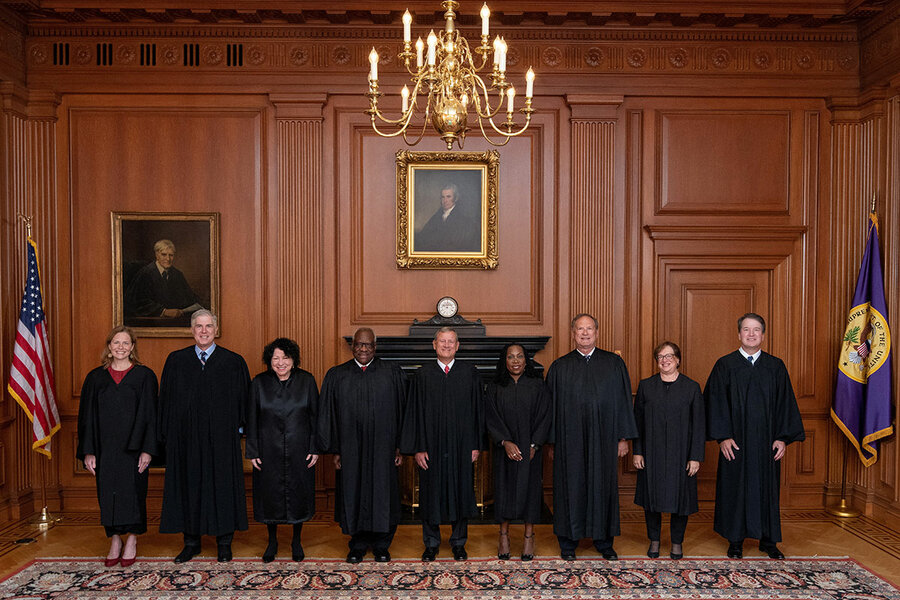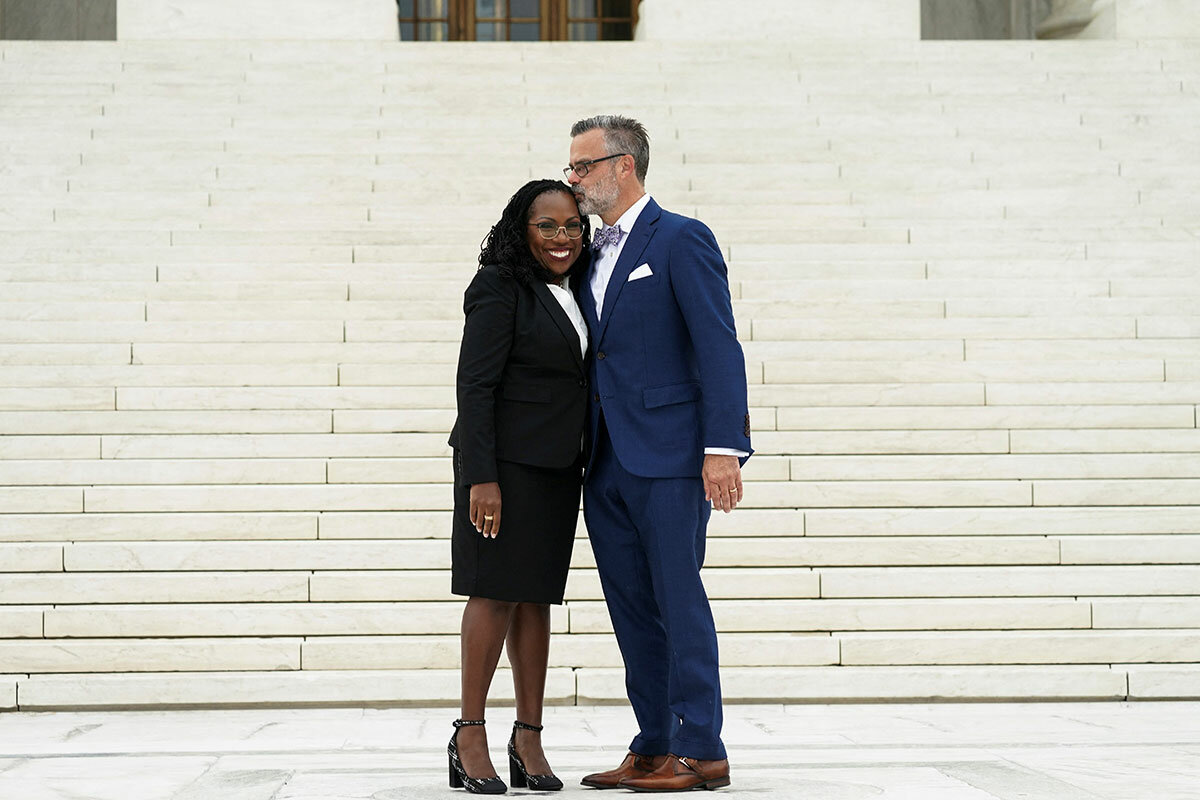Supreme Court: A new term, a new justice, a blockbuster docket
Loading...
The United States Supreme Court begins a new term today with one new justice, the same 6-3 ideological divide, historically low public approval ratings, and another docket littered with blockbuster cases.
Justice Ketanji Brown Jackson is the first Black woman to sit on the high court, which has a conservative supermajority in its second full term together. After taking a sharp rightward turn in the law – including overturning the right to abortion, expanding gun rights, strengthening religious freedom, and empowering courts to curb federal regulations – the court is again poised to hear a slate of cases with the potential to transform American life.
There are cases concerning the Clean Water Act and a Native American child-welfare law, as well as immigration enforcement. But the most high-profile cases this term concern race and elections.
Why We Wrote This
Often between extremes lies a more moderate option. In a number of cases this term, where the U.S. Supreme Court lands on that spectrum could transform American life.
“What we haven’t had yet with this new court really are cases about race, or the kind of deeply structural cases about how we govern ourselves,” says Linda Greenhouse, a longtime Supreme Court reporter for The New York Times who now teaches at Yale Law School.
“We’re going to have both of those in this coming term,” she adds. “Combined with the term we just lived through, we’re going to be living in a new constitutional landscape by the end of it.”
Many of those high-profile cases have “off-ramps” the justices can take to issue narrower, moderate rulings. But the justices have to agree to take them, says Steven Schwinn, a professor at the University of Illinois Chicago Law School.
“There was an off-ramp in Dobbs [the abortion case], there was an off-ramp in Bruen [the gun rights case], there was an off-ramp in West Virginia v. EPA,” the federal regulations case, he adds. “And the court just did not take them.”
303 Creative LLC v. Elenis
One case will see the court revisit a narrow decision it made in 2018, adjudicating a now-familiar conflict between gay rights and First Amendment protections.
The 2018 case saw a cake baker claim that having to make wedding cakes for same-sex couples violated his rights to free speech and free exercise of his religious beliefs. This case – 303 Creative LLC v. Elenis – involves a website designer, Lorie Smith, arguing that the same Colorado anti-discrimination law violates her free speech rights by forcing her to create websites with messages that contradict her beliefs about marriage.
The Supreme Court avoided ruling on the central questions in the earlier case, Masterpiece Cakeshop v. Colorado Civil Rights Commission. Instead, a fractured seven-justice majority opinion sided with the baker on procedural grounds.
303 Creative “will force the court to confront and really wrestle with [that central] conflict,” said Paul Clement, a solicitor general for former President George W. Bush, at a Heritage Foundation panel last week.
“One thing it won’t do is give the court the out it had in Masterpiece,” he added.
Before a court with a long record of expanding religious protections, Ms. Smith is expected to prevail. What the decision could mean for state anti-discrimination laws more generally – the more significant question – is less clear.
Merrill v. Milligan
One reason the court is unlikely to take a modest approach to this term’s major cases is that one of the court’s more modest members, Chief Justice John Roberts, has a long-running personal interest in several of them.
One of those is Merrill v. Milligan. Scheduled for oral argument this week, the case asks the justices to revisit a key section of the Voting Rights Act, a 1965 law that the chief justice has crusaded against for most of his career.
He wrote the majority opinion in Shelby County v. Holder, a 2013 case that gutted Section 4 of the Voting Rights Act, which required certain states with a history of racially discriminatory voting practices to get federal approval for changes to their voting laws. And last year, in Brnovich v. Democratic National Committee, he joined the court’s conservative majority in a ruling that an Arizona law placing new restrictions on voting and ballot collection didn’t violate Section 2 of the Voting Rights Act, which prohibits the use of discriminatory voting practices.
Section 2 is at issue again in Milligan, this time regarding racial gerrymandering. About 27% of Alabama’s voting-age population is Black, but in the state’s new congressional district map only one of seven districts is majority-Black. Local officials and activists sued, claiming the map violates Section 2, and, after a seven-day hearing in January, a three-judge district court ruled that it did, ordering Alabama to create a second majority-Black district.
Alabama’s argument to the Supreme Court is that the Voting Rights Act is requiring them to segregate Black voters, and that courts shouldn’t consider race in evaluating Section 2 challenges.
If the court rules in Alabama’s favor, “that would be a pretty significant change in the way Section 2 cases get litigated,” said Jeff Wall, an acting solicitor general under former President Donald Trump, at the Heritage Foundation panel last week – though it would depend “on what the court says,” he added.
The consequences could be even more significant than that, some experts believe, effectively weaponizing Section 2 against its intended purpose.
“It would severely curtail minority voters’ ability to choose candidates of their choice,” said Jonathan Diaz, senior legal counsel at the Campaign Legal Center, during an American Constitution Society panel last month.
“I don’t know how you remedy problems of historic race discrimination by saying race doesn’t exist,” he added.
Affirmative action
The justices will confront another racial issue in two cases being argued in late October. They concern affirmative action programs that Harvard University and the University of North Carolina use in their admissions processes.
The court has wrestled with affirmative action for decades – and it’s another issue about which Chief Justice Roberts has long been skeptical. “The way to stop discrimination on the basis of race is to stop discriminating on the basis of race,” he wrote in a 2007 affirmative action opinion.
So while the chief justice has often played a mediating role on the court in recent years, in the two affirmative action cases “he might actually be leading the court,” said Roman Martinez, a partner at Latham & Watkins and a former Roberts clerk, during a Georgetown University panel last month.
“Even if the court is willing to strike down Grutter” – a 2003 decision upholding university affirmative action programs – “there are options about how it does so,” he added.
An extreme ruling would bar universities from considering any kind of racial or ethnic diversity in admissions; a more moderate ruling would leave schools some leeway to promote diversity without considering race as a specific factor.
But on the current court “there are more votes that are skeptical [of affirmative action] than ever before,” said Mr. Martinez. “It’s not clear that that middle ground will prevail here.”
The independent state legislature theory
No single case has generated more pre-term attention than what’s officially known as Moore v. Harper, but better known as “the independent state legislature theory” case – or “the ISL” case, for short.
It concerns another congressional map, drawn by the North Carolina Assembly, that the state supreme court struck down as a partisan gerrymander. (Despite the state being divided about equally between Republicans and Democrats, the map would make Republicans likely to win 10 of the state’s 14 congressional seats.)
The North Carolina Assembly’s appeal to the Supreme Court centers on the fringe independent state legislature theory. The theory holds that the word “Legislature” in the elections clause of the Constitution means that only the state legislature has the power to set the rules for congressional elections in the state. State courts, governors, even statewide ballot initiatives would have no say.
Moore is a complicated case, and as with other high-profile cases this term, the court could rule in various ways. Three members of the conservative majority have expressed support for the theory, but other justices – likely including, in this case, Chief Justice Roberts – may be hesitant to rule that state courts have no say over federal elections in their states. The chief justice’s majority opinion in a 2018 partisan gerrymandering case implicitly left these questions for states to tackle individually.
“There’s been a lot of talk about this case as involving the end of democracy and things like that, and I think that’s a bit overblown,” said Hashim Mooppan, a lawyer at the firm Jones Day, during the Georgetown panel last month.
Yet, “it is quite important in terms of the rules of the road governing congressional elections,” he added. And “there’s a whole suite of things the court can do.”
Other court watchers believe those fears aren’t overblown.
“If they hold that state legislatures cannot be limited by state supreme courts or state governors in how elections are conducted, that’s just monumental,” says Eric Segall, a professor at Georgia State University College of Law.
The ruling “could potentially be quite modest,” says Professor Schwinn. But “I don’t think the court is going to make it modest because I don’t think that’s this court’s MO.”







